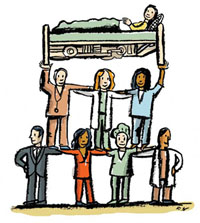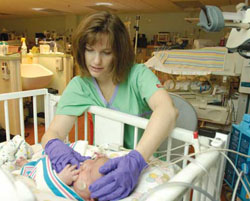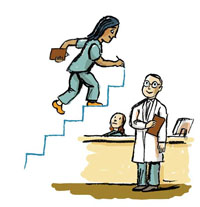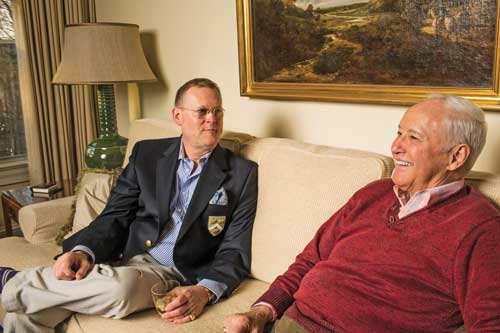By Elizabeth Heubecker
Illustrations by Robert Heubecker
 The image of the traditional bedside nurse of the last century–white stockings, crisply ironed skirt, and starched cap–is now a distant memory. But the core tradition of care and compassion remains, along with a continued commitment to serve as patient advocates in an increasingly complex medical system. These days, nurses are taking this core tenet of advocacy and coupling it with their drive for improvement, creativity in solving problems, and vision for the field of nursing. The result? New opportunities, more intriguing career paths, and emerging leadership roles.
The image of the traditional bedside nurse of the last century–white stockings, crisply ironed skirt, and starched cap–is now a distant memory. But the core tradition of care and compassion remains, along with a continued commitment to serve as patient advocates in an increasingly complex medical system. These days, nurses are taking this core tenet of advocacy and coupling it with their drive for improvement, creativity in solving problems, and vision for the field of nursing. The result? New opportunities, more intriguing career paths, and emerging leadership roles.
There is no question that today’s nurses face a more complex and challenging working environment than their predecessors. Patients are more seriously ill as hospitals now primarily serve people with emergency or catastrophic health issues. The amount of administrative work required of nurses has skyrocketed. And technological advances have completely changed how nurses perform many basic tasks. However, in the midst of these paradigm changes, Hopkins nurses have not only adapted, they have thrived.
In fact, nurses are taking a stronger stance on behalf of patients than ever before, leading interdisciplinary initiatives to ensure that patients receive care that is the safest, highest quality, and most ethically sound as possible. Nurses at the Johns Hopkins University School of Nursing (JHUSON) and the Johns Hopkins hospitals are applying their expansive knowledge of patient care to broaden their responsibilities as clinicians. And they have gone to great lengths to ensure that they are able to perform their jobs to their fullest potential, even taking the lead to reform state laws.
The articles that follow share a few examples of the leadership, creativity, and vision of Hopkins nurses-all of whom are contributing to the expansion of the profession.
Training Leaders for Nursing’s Future
 “To be an effective leader, one must have passion, a vision, and the appropriate tools. Hopkins helps define, determine, and develop these essential elements,” says doctor of nursing practice student Cheryl Bridges, MS, MBA, ACNP, who works at the Johns Hopkins Hospital as a nurse practitioner. “The profession of nursing, unlike medicine, public health, or pharmacology, has a unique position in the health care arena in that it approaches the patient from the perspective of the ‘whole’ system. We therefore have a duty to be our patients’ advocates.”
“To be an effective leader, one must have passion, a vision, and the appropriate tools. Hopkins helps define, determine, and develop these essential elements,” says doctor of nursing practice student Cheryl Bridges, MS, MBA, ACNP, who works at the Johns Hopkins Hospital as a nurse practitioner. “The profession of nursing, unlike medicine, public health, or pharmacology, has a unique position in the health care arena in that it approaches the patient from the perspective of the ‘whole’ system. We therefore have a duty to be our patients’ advocates.”
Other JHUSON graduates echo that mantra. “It’s a Hopkins tradition for nurses to always question the process and try to make it better. People there who do, end up rising through leadership roles,” says Deborah Baker, BS, MSN.
She should know. Having earned her baccalaureate degree from JHUSON in 1992, Baker returned to the school to obtain her MSN in 1997, then a Business of Nursing Certificate in 2001. Now, she is Director of Nursing Surgery at Johns Hopkins Hospital and president of the Johns Hopkins Nurses’ Alumni Association.
The school’s faculty acknowledge their emphasis on nurse leadership and autonomy. “Sometimes, in the culture of medicine, the nurses’ perspective is dismissed. I want my students to embrace the knowledge and perspective that they bring and not apologize for it,” says associate professor Cynda Rushton, DSNc, RN, FAAN.
“If we can establish more communication among physicians, nurses, and administrators, then I believe the quality of health care will improve by leaps and bounds,”
— Peter Cornell ’03, CRNP ’06
At Hopkins, professors do more than talk the leadership talk. They give students real-life opportunities to walk the leadership walk. One such example is Achieving Competence Today (ACT), a program funded by the Robert Wood Johnson Foundation. As part of a multi-site national pilot, Hopkins assembled teams of graduate nursing, medical, and health administration students to participate in the planning of quality improvement projects. In this interdisciplinary setting, nursing students demonstrate the unique perspective they bring to the table–and learn how theirs fits in with other health care disciplines.
“It’s not often enough that we sit down together and think about how we can provide better care as a team. If we can establish more communication among physicians, nurses, and administrators, then I believe the quality of health care will improve by leaps and bounds,” says Peter Cornell ’03, CRNP ’06, who participated in the ACT program in 2005 when he was an acute care nurse practitioner student at JHUSON.
Reaching Beyond the Call of Duty
In addition to her duties as a nurse in the Neonatal Intensive Care Unit, Brenda Blunt serves as chairperson of an interdisciplinary Perinatal Bereavement Committee at the Johns Hopkins Bayview Medical Center.

Time and time again, graduates from JHUSON programs demonstrate how far they can go professionally when their natural leadership qualities are cultivated in an educational atmosphere that not only accepts, but rewards, these traits.
Consider Brenda Blunt, who graduated in 2006 from the school’s baccalaureate program. After less than two years as a registered nurse at Johns Hopkins Bayview Medical Center’s Neonatal Intensive Care Unit, Blunt has added to her nursing responsibilities the role of chairperson on the unit’s interdisciplinary Perinatal Bereavement Committee. Blunt did not seek to carve out a leadership role for herself in the NICU. But after just a short stint on the unit, she was prepared to lead this important initiative.
“I’ve always been a caretaker,” Blunt says. Now, in addition to caring for her infant charges, she’s making sure family members of NICU patients are taken care of–specifically, family members of patients who don’t survive.
As a NICU nurse, Blunt was trained to care for the youngest and frailest of infants. There is nothing in her job description that requires her to respond to the needs of family members too, but instinctively, she recognized the need and took action. “I’m assertive when I need to be,” Blunt says.
One of the current goals of the bereavement committee is to support grieving families according to their preferences and values. Under Blunt’s direction, the committee has closely examined how specific populations cope with loss. “We’re looking at different cultures and how they grieve, so we don’t impose our practices and ideas on them,” Bunt explains.
The committee will pass on this knowledge to other NICU nurses. “It’s about making nurses more comfort-able supporting families who are dealing with a loss,” Blunt says. Many NICU nurses, exceptional at caring for the most delicate infants, have no idea how to support a family broken by grief. Blunt has no qualms under these circum-stances. “It’s an honor to be able to help families in such a tragic time,” she says.
Enhancing Patient Care Systems

In recent years, hospitals have become increasingly accountable for their performance. Governing bodies like the Centers for Medicare and Medicaid Services (CMS) and The Joint Commission on the Accreditation of Healthcare Organizations (JCAHO) have ramped up hospitals’ accountability considerably, threatening financial consequences for those who don’t comply. “These accrediting bodies are saying ‘We’re going to make you report how you’re doing, compare you to other organizations, and pay you according to your performance,'” explains JHUSON assistant professor Cheryl Dennison, PhD, ANP, a nurse researcher who has dedicated her professional career to interdisciplinary projects that achieve improved patient outcomes.
Some might balk at these increasingly stringent regulations. Dennison, along with colleagues in the hospital, instead has initiated creative and practical interdisciplinary solutions that both satisfy the demands imposed by today’s increasingly complex health care system and provide practicing nurses and physicians tools they need to give high quality care.
“Nurses are in a great position to participate and lead interdisciplinary teams,” says Dennison. She counts herself among them. “Nurses are rich with ideas of what patients, providers, and systems need.”
In her latest interdisciplinary research project, Dennison hopes to dramatically boost Hopkins physicians’ and nurses’ use of standardized, evidence-based guidelines to treat heart failure, a major public health problem that costs $33.2 billion annually. Through a $400,000 grant from the National Institute of Nursing Research at the National Institutes of Health, Dennison is leading an interdisciplinary team from the hospital in the ambitious project of developing multi-faceted electronic clinician decision support tools (CDS) that apply specifically to managing heart failure in the acute care setting.
“Nurses are in a great position to participate and lead interdisciplinary teams,” says Dennison. She counts herself among them. “Nurses are rich with ideas of what patients, providers, and systems need.”
–Cheryl Dennison, PhD, ANP, assistant professor
Ideally, her work will result in higher utilization of the treatment guidelines, thereby improving patient outcomes and lowering health care costs. Along the way, the outcomes of her research may help satisfy stringent standards imposed by accrediting bodies.
The task, which sounds relatively simple, is anything but. It has involved several steps, beginning with engaging an interdisciplinary improvement team, then developing a key stakeholder assessment, cataloguing all existing information systems, recruiting and holding nurse and physician focus groups, pilot testing paper-based versions of CDS solutions, converting them to electronic versions, and meticulously following up with assessments, feedback, and revisions.
Dennison’s work involves several targeted initiatives. Nurses are completing online education modules on managing heart failure; standardized patient education materials have been developed. And, computerized provider order sets have been implemented at critical junctures-upon admission and at discharge. “We didn’t want our efforts to become too diffuse…we’ve carved out a feasible approach,” she says.
While acknowledging the research project’s limited parameters, Dennison nevertheless forges ahead with ideas about potential future applications. “As the hospital introduces these new technology systems, they also increase our ability to capture data on the quality of care. This allows us to monitor the effects of our interventions.”She adds, “We have fabulous nurses and physicians here. But if the system isn’t set up for providers to provide the best care, it can be challenging. It’s an issue of creating a system that allows good nurses and doctors to provide the best care.”
Ensuring Patient Safety
As hospital operations and patient caseloads become ever more complex, the issue of patient safety reigns paramount. And, once again, Hopkins nurses like Lori A. Paine, RN, MS, Patient Safety Manager for Johns Hopkins Medicine, have stepped forward to lead the effort.
A former labor and delivery nurse, Paine knows firsthand the issues within any modern hospital that can thwart patient safety. “There’s more documentation required. Patients are even sicker. The technology to treat patients has become more complex. It’s hard out there, on the front line,” she says.
Generally, there is no single element that presents challenges to patient safety-just as medical errors are rarely the result of one employee’s mistakes. That’s why Paine and her staff approach the challenge of creating a safer hospital environment for patients by looking at system-wide solutions. This perspective, believes Paine, reflects the way nurses in general approach their work.
“Nurses think holistically. We look at the whole patient. With patient safety, we look at the whole system-how one part relates to the broken part of the system,” Paine says.
The Patient Safety Net is one example of this system-wide approach that Paine and her colleagues have implemented at Hopkins. It’s an online safety reporting system whereby any staff member can report events that involve harm or near harm to a patient. “As soon as a front-line reporter clicks ‘submit’, the report goes automatically to the appropriate people,” Paine says.
The system takes a proactive, interdisciplinary approach to patient safety. “We focus on those events of lower harm that may fly under the radar screen. We fix them before somebody gets hurt,” Paine says.
The patient safety team accomplishes this goal by gathering a multi-disciplinary group weekly to review reported events that could lead to potential harm and discussing collective solutions. “We now recognize that teams which don’t work together don’t provide as safe care,” Paine says.
The team stays busy. Each week, the Patient Safety Network receives between 250 and 275 event reports; that’s 11,000 per year. These impressive numbers indicate what Paine had hoped for: a proactive approach to patient safety is taking hold at Hopkins.
Driving Discussions for Ethical Care
The medical technology available to today’s health care providers is more advanced than ever before. While these sophisticated advances allow clinicians to perform life-saving techniques, they sometimes create unintended ethical challenges, like when and to what extent to use such technology on patients. All too often, patient-centered ethical concerns get buried in the fast-paced hospital setting–particularly when no one knows quite how or when to initiate the sensitive dialogue these issues deserve.
At Hopkins, the complex ethical questions that have grown parallel to the rise in medical innovations are the intentional focus of open dialogue between providers, patients, family members, and other involved parties. This discourse takes place in the context of the Johns Hopkins Ethics Committee. Created some 20 years ago by a group of committed Hopkins clinicians, the committee ensures that no single person or group needs to face difficult ethical questions alone. The group makes itself available to consult with patients, family members, and the patient’s medical team.
JHUSON associate professor Cynda Rushton, DNSc, RN, FAAN says, “Nurses have the closest and most sustained contact with patients and families. Because of that proximity, they witness the suffering of patients very intimately.”
So, it was no surprise when Rushton was chosen to serve as co-chair for a committee that coordinates a diverse group of health care professionals to advocate on behalf of patients. “We try to provide a systematic process, to create an open dialogue-a space where people can hear each other differently. We are not the judge and jury.”
Many times, it’s not the end result of this dialogue that counts. “We help to slow down the process and facilitate a conversation among patients, families, and the health care team that may not have happened before this. Even if decisions don’t change, people feel as though they’ve been heard,” Rushton says.
When she took the helm of the committee almost 10 years ago, Rushton aimed to increase its interdisciplinary leadership. She relishes the results of having met those goals. “We needed to increase the voice of nurses, of community members, and others,” says Rushton, acknowledging that prior to 1999, the committee was comprised primarily of physicians. “Now, we have a much more balanced membership that brings diverse and important perspectives,” she adds, noting an increase in the number of chaplains, social workers, and nurses on the committee.
Speaking from experience, Rushton openly extols the virtues that nurses bring to the committee. “Nurses have the closest and most sustained contact with patients and families. As a result, we often have the deepest relationships with them. Because of that proximity, we witness the suffering very intimately. We also are involved in trying to coordinate an often–complex and diverse group of healthcare professionals to try to advocate on behalf of the patients,” she says.
Breaking Down Barriers
Some pressing conversations about patient care extend far beyond the borders of medical facilities. Consider the work of JHUSON associate professor and nurse practitioner Julie Stanik-Hutt, PhD, ACNP who, in just four years, drove discourse that paved the way for nurse practitioners to practice their profession to a broader patient population. A nurse practitioner by training, Stanik-Hutt served between 2002 and 2006 as the Legislative Committee Chairperson for the Nurse Practitioner Association of Maryland, an organization which recently named her president.
Before 2003, a glitch in Maryland law precluded nurse practitioners from being designated primary care providers to patients carrying HMO insurance. Given the large number of patients with HMOs and the current physician shortage, that small glitch created a big gap in care for many Marylanders-one that Stanik-Hutt was determined to close.
“Some places, especially rural and underserved inner city areas, only have nurse practitioners. If insurance won’t accept a nurse practitioner as a primary care provider, you don’t get the care you need,” Stanik-Hutt says.
She describes the long and tedious process that ensued. “We went to bat [for those populations]. We went to the legislature and, for several years, had a lot of opposition. Then, a movement within organized medicine on the physician side said ‘Let’s collaborate; let’s see if we can make an agreement’. I worked out a compromise with physicians, and testified in support of a bill that physicians originally opposed. It passed, and Governor Erlich signed it,” Stanik-Hutt says.
While working with top state law officials, Stanik-Hutt has remained true to her role as patient advocate. “It’s something that nurses are–advocates for their patients. If you see something that isn’t right and it needs to be fixed, we fix it,” she says.
More on “The New Face of Nursing”…
 President’s Message
President’s Message Birthday Hero
Birthday Hero The Alcohol Question
The Alcohol Question Lions and midwives and AIDS, oh my!
Lions and midwives and AIDS, oh my!







